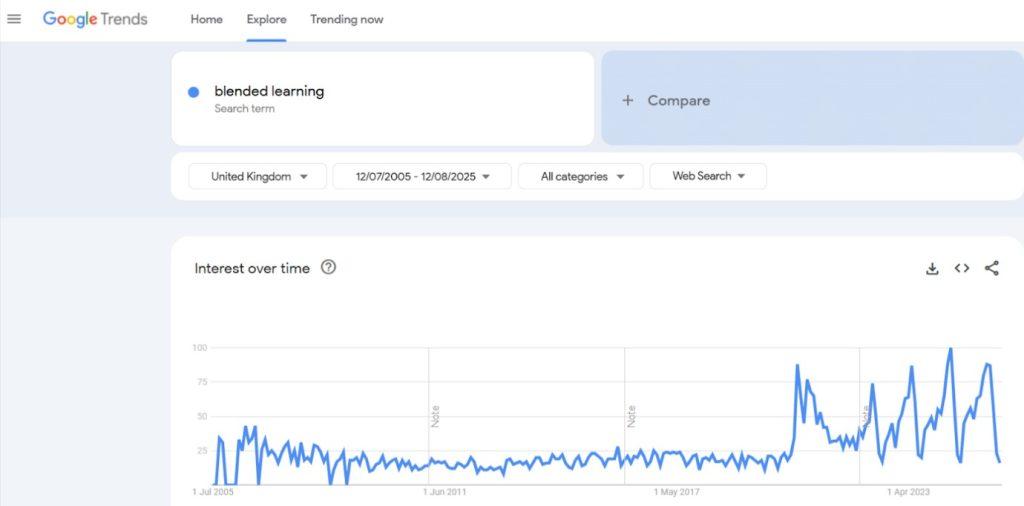Blended Learning – Definition
Blended learning is now at the heart of UK education policy and everyday teaching. But why does it matter so much?
Education technology is rapidly transforming how lessons are delivered, how students engage, and even what it means to “learn well” today in the UK.
Blended learning is the model driving this change.
For teachers, parents, and students alike, knowing what it means can make a real difference in outcomes and engagement.
Here are three widely accepted official definitions of blended learning:
- Joint Information Systems Committee blended learning definition – “Blended learning is the thoughtful integration of classroom face-to-face learning experiences with online learning experiences.” (Source: Jisc – Beyond Blended)
- Office for Students (OfS) blended learning definition – “Blended learning is an approach to course delivery that combines elements of face-to-face and online learning in a planned, pedagogically sound manner.” (Source: OfS – Blended Learning Review)
- Wikipedia blended learning definition – “Blended learning is an approach to education that combines online educational materials and opportunities for interaction online with traditional place-based classroom methods.” (Source: Wikipedia – Blended Learning)
These blended learning definition examples show common themes: deliberate design, a mix of online and in-person elements, and a focus on enhancing the learning experience.
Evolution of Blended Learning
Blended learning began to emerge in the 1990s in UK higher education. Around this time, universities started to combine face-to-face lectures with early virtual learning environments.
In the 2010s, UK sector bodies like the Jisc shifted guidance from “adding technology” to “designing the blend”.
Jisc’s Beyond Blended framework maps learning activities on two axes:
- time (synchronous vs asynchronous)
- place (on-campus vs online)
This model aims to help educators select the most pedagogically valuable combination.
During 2020, emergency remote teaching rapidly expanded digital delivery. Post-pandemic, the focus turned to quality and outcomes.
Note: Google Trends data for the UK shows interest in “blended learning” surged in 2020 (Dec 2019 score 12 → June 2020 score 88), reflecting this rapid shift.

Current Trends and Stats Around Blended Learning in UK Education
- University Adoption: Nearly a third (28%) of UK university courses in the 2022-23 academic year were delivered using a hybrid or blended model. (Source: BBC News)
- Secondary School Uptake: By 2024, an estimated 68% of UK secondary schools had adopted blended approaches to improve teaching delivery and student engagement. (Source: Straits Research)
- Professional community data – The ALT Annual Survey 2023/24 found that blended/hybrid modes are now the main mode in UK institutions, with student engagement as the top driver for adoption. (Source: Association for Learning Technology)
Insights About Blended Learning from Research and Regulatory Sources
- Pedagogy matters most – The Education Endowment Foundation (EEF) finds that the quality of teaching—clarity of explanation, effective questioning, timely feedback—has more impact than the choice of medium. (Source: EEF – Remote Learning Evidence Review)
- Fundamental pedagogy remains unchanged – The Department for Education’s remote education research stresses that all key pedagogical principles (as embodied in the Teachers’ Standards and the Ofsted Inspection Framework) apply just as strongly in blended settings. What shifts is how teachers maintain presence and foster interaction between teacher and learners and among peers across both online and in-person sessions. (Source: Department for Education)
- Sector consensus – QAA thematic analyses highlight that digital provision is now an expected part of the student experience. Institutions are focusing on “getting the blend right” rather than questioning whether to blend at all. (Source: QAA Scotland)
If you want to share more information related to this topic with us, feel free to get in touch.
Disclaimer: All the information provided was correct at the time of publication (August 2025) and was collected with the help of accredited tools and AI.
Author Profile
- Publishing the latest education, EdTech and career news.
Latest entries